Nervous System | Science - Book Back Questions with Answers | 10th Science : Chapter 15 : Nervous System
Chapter: 10th Science : Chapter 15 : Nervous System
Book Back Questions with Answers
Nervous System (Science)
I. Choose the correct answer
1. Bipolar neurons are found in
(a) retina of eye
(b) cerebral cortex
(c) embryo
(d) respiratory epithelium
2. Site for processing of vision, hearing, memory, speech, intelligence and thought is
(a) kidney
(b) ear
(c) brain
(d) lungs
3. In reflex action, the reflex arc is formed by
(a) brain, spinal cord, muscle
(b) receptor, muscle, spinal cord
(c) muscle, receptor, brain
(d) receptor, spinal cord, muscle
4. Dendrites transmit impulse ________ cell body and axon transmit impulse ________ cell body.
a) away from, away from
b) towards, away from
c) towards,towards
d) away from, towards
5. The outer most of the three cranial meninges is
(a) arachnoid membrane
(b) piamater
(c) duramater
(d) myelin sheath
6. There are ________ pairs of cranial nerves and ________ pairs of spinal nerves.
(a) 12, 31
(b) 31, 12
(c) 12, 13
(d) 12, 21
7. The neurons which carries impulse from the central nervous system to the muscle fibre.
(a) afferent neurons
(b) association neuron
(c) efferent neuron
(d) unipolar neuron
8. Which nervous band connects the two cerebral hemispheres of brain?
(a) thalamus
(b) hypothalamus
(c) corpus callosum
(d) pons
9. Node of Ranvier is found in
(a) muscles
(b) axons
(c) dendrites
(d) cyton
10. Vomiting centre is located in
(a) medulla oblongata
(b) stomach
(c) cerebrum
(d) hypothalamus
11. Nerve cells do not possess
(a) neurilemma
(b) sarcolemma
(c) axon
(d) dendrites
12. A person who met with an accident lost control of body temperature, water balance, and hunger. Which of the following part of brain is supposed to be damaged?
(a) Medulla oblongata
(b) cerebrum
(c) pons
(d) hypothalamus
II. Fill in the blanks
1. Neuron is the longest cell in our body.
2. Impulses travels rapidly in multipolar neurons.
3. A change in the environment that causes an animal to react is called stimulus.
4. Dendrite carries the impulse towards the cell body.
5. The two antagonistic component of autonomic nervous system are sympathetic nerves and para sympathetic nerves.
6. A neuron contains all cell organelles except
7. cerebro spinal fluid maintains the constant pressure inside the cranium.
8. sulci and gyri increases the surface area of cerebrum.
9. The part of human brain which acts as relay center is thalamus.
III. State whether true or false, if false write the correct statement
1. Dendrons are the longest fibres that conducts impulses away from the cell body. - False
Dendrone are the longest fibres and they conduct impulses towards cell body.
2. Sympathetic nervous system is a part of central nervous system. - False
Sympathetic nervous system is a part of autonomous nervous system.
3. Hypothalamus is the thermoregulatory centre of human body. - True
4. Cerebrum controls the voluntary actions of our body.
Cerebellum controls the voluntary actions of our body.
5. In the central nervous system myelinated fibres form the white matter.
6. All the nerves in the body are covered and protected by meninges.
The brain and spinal cord are covered and protected by meninges.
7. Cerebrospinal fluid provides nutrition to brain.
8. Reflex arc allows the rapid response of the body to a stimulus.
9. Pons helps in regulating respiration.
IV. Match the following
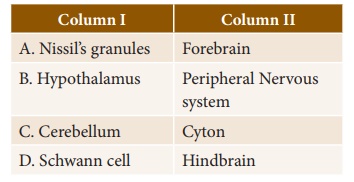
Column I : Column II
A. Nissil’s granules : Cyton
B. Hypothalamus : Forebrain
C. Cerebellum : Hindbrain
D. Schwann cell : Peripheral Nervous system
V. Understand the assertion statement. Justify the reason given and choose the correct choice
a. Assertion is correct and reason is wrong
b. Reason is correct and the assertion is wrong
c. Both assertion and reason are correct
d. Both assertion and reason are wrong
1. Assertion: Cerebrospinal fluid is present throughout the central nervous system.
Reason: Cerebrospinal fluid has no such functions.
Answer: a. Assertion is correct and reason is wrong
2. Assertion: Corpus callosum is present in space between the duramater and piamater.
Reason: It serves to maintain the constant intracranial pressure.
Answer: d. Both assertion and reason are wrong
VI. Short answer questions
1. Define stimulus.
‘Stimulus’ refers to the changes in the environmental condition, that are detected by receptors present in the body. Relevant changes in the activities of organisms to a particular stimuli are called their reactions or responses.
2. Name the parts of the hind brain.
It is formed of three parts cerebellum, pons and medulla oblongata.
3. What are the structures involved in the protection of brain?
The brain is covered by three connective tissue membranes or meninges:
(i) Outer Duramater
(ii) Middle arachnoid
(iii) Inner piamater
It protects the brain from mechanical injury.
4. Give an example for conditioned reflexes.
Playing a harmonium by striking a particular key on seeing a music note is an example of conditioned reflex.
5. Which acts as a link between the nervous system and endocrine system?
Hypothalamus of the fore brain acts as a link between nervous and endocrine system.
6. Define reflex arc.
The pathway taken by nerve impulse to accomplish reflex action is called reflex arc.
VII. Differentiate between
1. Voluntary and involuntary actions.
Voluntary actions
1. Actions performed with our will and control are called voluntary actions.
2. They are controlled by the cerebellum.
involuntary actions
1. Actions performed without our control are called involuntary actions.
2. They are controlled by the medulla and spinal cord.
2. Medullated and non-medullated nerve fibre.
Medullated nerve fibre
1, The axon of the neuron is covered with myelin sheath.
2. It forms the white matter of the brain
Non-medullated nerve fibre
1. The axon of the neuron is not covered with myelin sheath.
2. It forms the grey matter of the brain
VIII. Long answer questions
1. With a neat labelled diagram explain the structure of a neuron.
Answer:
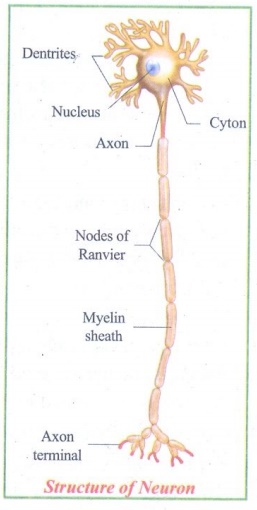
A
neuron typically consists of three basic parts: Cyton,
Dendrites and Axon.
(i) Cyton:
(a) Cyton is also called cell
body or perikaryon. It has
a central nucleus with abundant cytoplasm called neuroplasm.
(b) The cytoplasm has large granular body called Nissl’s granules and the other cell organelles
like mitochondria, ribosomes, lysosomes, and endoplasmic recticulum.
(c) Neurons do not have the ability to divide.
(ii) Dendrites :
(a) These are the numerous branched cytoplasmic
processes that project from the surface of the cell body. They conduct nerve
impulses towards the cyton.
(b) The branched projections increase the surface area
for receiving the signals from other nerve cells.
(iii) Axon :
(a) The axon is a single, elongated, slender
projection. The end of axon terminates as fine branches which terminate into
knob like swellings called synaptic knob.
(b) The plasma membrane of axon is called axolemma, while the cytoplasm is called axoplasm. It carries impulses away from the
cyton.
(c) The axons may be covered by a protective sheath
called myelin sheath which is further
covered by a layer of Schwann cells
called neurilemma.
(d) Myelin sheath breaks at intervals by depressions
called Nodes of Ranvier. The region between
the nodes is called as internode.
Myelin sheath acts as insulator and ensures rapid transmission of nerve
impulses.
(iv) Synapse:
(a) A junction between synaptic knob of axon of one
neuron and dendron of next neuron is called synaptic
junction.
(b) Information from one neuron can pass to another
neuron through these junctions with the release of chemicals known as neurotransmitters from the synaptic knob.
2. Illustrate the structure and functions of brain.
Answer:
A
human brain is formed of three main parts:
(a)
forebrain (b) midbrain and (c) hindbrain.
Forebrain : The
forebrain is formed of cerebrum and diencephalon. The latter consists of dorsal
thalamus and ventral hypothalamus.
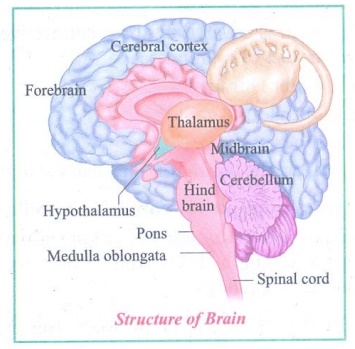
Cerebrum :
(i) It is the largest portion forming nearly two-third
of the brain. The cerebrum is longitudinally divided into two halves called cerebral hemispheres by a deep cleft which are
interconnected by thick band of nerve fibres
called corpus callosum.
(ii) The outer portion of each cerebral hemisphere is
formed of grey matter and is called cerebral
cortex. The inner or deeper part is formed of white matter and is
called cerebral medulla.
(iii) The cortex is extremely folded forming elevations
called gyri with depressions between
them termed as sulci that increase
its surface area.
(iv) The cerebrum is also responsible for the
thinking, intelligence, consciousness, memory, imagination, reasoning and
willpower.
Thalamus : Thalamus present in cerebral medulla is a
major conducting centre for sensory and motor signalling. It acts as a relay centre.
Hypothalamus :
(i) It lies at the base of the thalamus.
(ii) It controls involuntary functions like hunger,
thirst, sleep, sweating, sexual desire, anger, fear, water balance, blood
pressure etc.
(iii) It acts as a thermoregulatory
(temperature control) center
of the body.
(iv) It controls the secretion of hormones from
anterior pituitary gland and is an important link between nervous system and
endocrine system.
Midbrain :
(i) It is located between thalamus and hind brain.
(ii) It consists of four rounded bodies called corpora quadrigemina that control visual and
auditory (hearing) reflexes.
Hindbrain :
It
is formed of three parts cerebellum, pons
and medulla oblongata.
Cerebellum : It is second largest part of the brain
formed of two large sized hemispheres and middle vermis. It coordinates
voluntary movements and also maintains body balance.
Pons : It is a bridge of nerve fibre that connects the
lobes of cerebellum. It relay signals between the cerebellum, spinal cord,
midbrain and cerebrum. It controls respiration and sleep cycle.
Medulla Oblongata :
(i) Medulla oblongata is the posterior most part of
the brain that connects spinal cord and various parts of brain.
(ii) It has cardiac centres, respiratory centres,
vasomotor centres to control heart beat, respiration and contractions of blood
vessels respectively. It also regulates vomiting and salivation.
3. What will you do if someone pricks your hand with a needle? Elucidate the pathway of response with a neat labelled diagram.
Answer:
If
some one pricks our hand with a needle, we will immediately pull our hand to
protect ourselves. This is an example of a reflex
action.
Reflex action : A reflex is any response that
occurs automatically without consciousness. Most of the reflex actions are
monitored and controlled by the spinal cord. Hence they are also known as spinal reflexes.
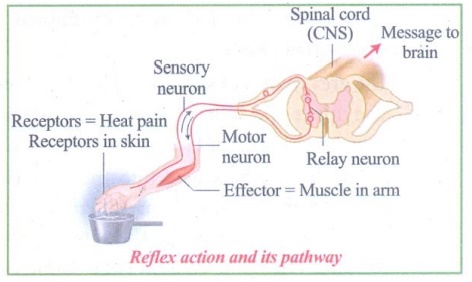
Reflex arc: The pathway taken by nerve impulse to
accomplish reflex action is called reflex arc.
(i) When we are pricked by a needle, the stimulus is
the prick which is sensed by receptors in our hand. This stimulus (pain) inturn
triggers an impulse in sensory neuron.
(ii) The sensory neuron
transmits or conveys the message to the spinal cord.
(iii) Spinal cord interprets the stimulus and the
impulse is passed on to the relay neuron which inturn transmits it to a motor
neuron.
(iv) Motor neurons carry command from spinal cord
to our arm.
(v) Muscle in our arm contracts and we withdraw our
hand immediately from the needle.
In
this example, muscle is an effector organ which has responded to the pain.
4. Describe the structure of spinal cord.
Answer:
Spinal Cord :
(i) Spinal cord is a cylindrical structure lying in
the neural canal of the vertebral column. It is also covered by meninges. It
extends from the lower end of medulla oblongata to the first lumbar vertebra.
(ii) The posterior most region of spinal cord tapers
into a thin fibrous thread like structure called filum
terminale.
(iii) Internally, the spinal cord contains a
cerebrospinal fluid filled cavity known as the central
canal.
(iv) The grey matter of spinal cord is ‘H’ shaped. The
upper end of letter 'H' forms posterior horns and lower end forms anterior
horns.
(v) A bundle of fibres pass into the posterior horn
forming dorsal or afferent root. Fibres pass outward from the anterior horn
forming ventral or efferent root. These two roots joins to form spinal nerves.
(vi) The white matter is external and have bundle of
nerve tracts.
(vii) Spinal cord conducts sensory and motor impulses to
and from the brain. It controls reflex actions of the body.
5. How nerve impulses are transferred from one neuron to next neuron?
Answer:
(i) All the information from the environment are
detected by the receptors located in our sense organs such as the eyes, the
nose, the skin etc.
(ii) Information from the receptors is transmitted as
electrical impulse and is received by the dendritic tips of the neuron.
(iii) This impulse travels from the dendrite to the
cell body and then along the axon to its terminal end.
(iv) On reaching the axonal end, it causes the nerve
endings to release a chemical (neurotransmitter) which diffuses across a
synapse and starts a similar electrical impulse in the dendrites of the next
neuron, then to their cell body to be carried along the axon.
(v) In this way, the electrical signal reaches the
brain or spinal cord.
(vi) The response from brain (or spinal cord) is
similarly passed on to the effector organs such as the muscle or gland cell,
that undergoes the desired response.
(vii) The flow of nerve impulses from axonal end of one
neuron to dendrite of another neuron through a
synapse is called synaptic transmission.
(viii) Neurotransmitters : Neurotransmitters are the
chemicals which allow the transmission of nerve impulse from the axon terminal
of one neuron to the dendron of another neuron or to an effector organ. The important neurotransmitter
released by neurons is called Acetylcholine.

6. Classify neurons based on its structure.
Answer:
The
neurons may be of different types based on their structure and functions.
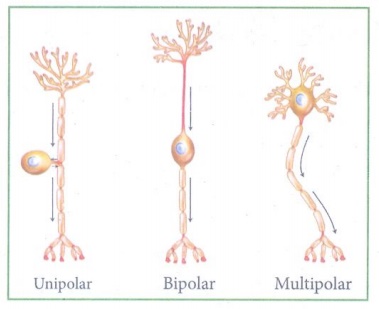
Structurally
the neurons may be of the following types:
(i) Unipolar neurons : Only one nerve process arises
from the cyton which actsas both axon and dendron.
(ii) Bipolar neurons : The cyton gives rise to two
nerve processes of which one acts as an axon while another as a dendron.
(iii) Multipolar neurons : The cyton gives rise to
many dendrons and an axon.
Types of Nerve Fibres : Nerve fibres are of two types
based on the presence or absence of myelin sheath.
(i) Myelinated nerve fibre : The axon is covered with
myelin sheath
(ii) Non-myelinated nerve fibre : The axon
is not covered by myelin sheath.
Myelinated
and non-myelinated nerve fibres form the white matter and grey matter of the
brain.
IX. Higher Order Thinking Skills (HOTS)
1. ‘A’ is a cylindrical structure that begins from the lower end of medulla and extend downwards. It is enclosed in bony cage ‘B’ and covered by membranes ‘C’. As many as ‘D’ pairs of nerves arise from the structure ‘A’.
(i) What is A?
(ii) Name (a) bony cage ‘B’ and (b) membranes ‘C’
(iii) How much is D?
Answer:
(i) A refers to the spinal cord.
(ii) (a) Bony cage 'B' refers to the vertebral column.
(b) 'C' refers to meninges.
(iii) D - 12 pairs of nerves.
2. Our body contains a large number of cells ‘L’ which are the longest cells in the body. L has long and short branch called as ‘M’ and ‘N’ respectively. There is a gap ‘O’ between two ‘L’ cells, through which nerve impulse transfer by release of chemical substance ‘P’.
(i) Name the cells L
(ii) What are M and N?
(iii) What is the gap O?
(iv) Name the chemical substance P
Answer:
'L' refers to neurons.
(ii) 'M' - Dendrites, 'N' - Axon
(iii) 'O' - Synapse
(iv) The chemical substance 'P' is acetylcholine

Related Topics